Simplified Network Deployment | Provides four PnP deployment modes: deployment through app-based barcode scanning, deployment through DHCP, deployment through the registration query center, and deployment through the email. The four modes are applicable to different network scenarios. With deployment mode diversity, CloudCampus@iMaster NCE-Campus can implement GUI-based network planning and deployment and provision network services in minutes, greatly simplifying network deployment and shortening network construction periods. |
Automatic Virtual Network Service Provisioning | Supports VXLAN-based automatic virtual network deployment, GUI-based fabric planning, configuration, and provisioning, and E2E VXLAN-based automatic network deployment, achieving service isolation and one network for multiple purposes. Supports service configuration visualization, topology-based virtual network configuration and monitoring, and real-time service provisioning status query. Automatically establish VXLAN tunnels through BGP EVPN. Supports centralized and distributed VXLAN gateway solutions, providing flexible expansion and high efficiency. |
SD-WAN Convergent Management | Adopts Ethernet Virtual Private Network (EVPN) and cloud computing to implement automatic deployment of HQ-branch and branch-branch leased line services, providing cloud-based leased line service management for enterprises, reducing enterprise OPEX, and accelerating service cloudification and digital transformation. Automatic deployment of HQ-branch and branch-branch lease line services: automatic configuration of all services including service policies, value-added services (VASs), and dynamic VPN connections, simplifying branch network deployment. Application experience-prior: Agile supports comprehensive traffic steering considering bandwidth and link quality. O&M and network-wide application traffic visualization: supports visualized management by application and link, network-wide status visualization, and real-time network status awareness, improving O&M efficiency. |
Multi-tenant Management | A cloud management model based on physical sharing and logical isolation. It supports multi-tenant management by user role and region, and provides flexible rights- and domain-based management for enterprise users. Adopts a three-level management model: The system administrator is responsible for platform-wide management and O&M. The MSP administrator can create tenants and provide construction and maintenance services for tenants. The tenant administrator is responsible for deployment and O&M of the local network; alternatively, the tenant administrator can authorize an MSP to manage tenant networks. Supports rights- and domain-based management. In the three-level management model, administrators can be set by role and site to secure network management. Services are invisible between tenants. Data of different tenants is isolated in an E2E manner and distinguished by tenant IDs in the database. In addition, only the corresponding tenant administrator can access data of a tenant. This ensures tenant data security to the most extent. |
User Access Authentication | Introduces new authentication protocol HTTP2.0, and can authenticate a large number of network devices and users using various access authentication modes, such as 802.1X authentication, Portal authentication, SMS authentication, and social media authentication. It also provides multiple user access control policies. This significantly improves network security. Users decoupled from IP addresses, allowing users to access the network anytime, anywhere with consistent permissions. This ensures free mobility and consistent user experience, ensuring user experience while meeting permission control requirements. |
Intelligent terminal identification | Built-in terminal fingerprint library: Multiple intelligent identification methods are combined to accurately identify terminal types. Massive IoT terminals are connected intelligently, and policies are automatically matched and delivered, making IoT terminals plug-and-play. |
Intelligent HQoS | HQoS scheduling based on users and service priorities: Different policies are implemented for different users and applications, achieving more refined bandwidth policy control and effectively ensuring user access experience. |
Intelligent O&M | Provides GIS-based networking monitoring, network inspection, and health evaluation to monitor device alarms in real time and detect network conditions in advance for fault prevention. If a fault occurs, iMaster NCE-Campus provides various fault locating methods to quickly locate and rectify the fault. Real-time experience visibility for each application of each user in each area: With fault backtracking, iMaster NCE-Campus quickly and intelligently demarcates faulty devices and analyzes root causes for poor quality. Continuously trained AI algorithm: Through proactive issue identification, fault locating in minutes, and intelligent fault prediction, iMaster NCE-Campus identifies 90% of potential network faults and provides optimal rectification suggestions. Real-time wireless network channel conflict evaluation: iMaster NCE-Campus performs predictive radio calibration, and compares gains before and after calibration, improving network performance by more than 50%. |
Capability Openness | Provides 170+ northbound RESTful APIs for user management, topology management, access authentication, service configuration, and performance monitoring. Leveraging such APIs, Huawei joins hands with 30+ partners to release 30+ industry applications for iMaster NCE-Campus. This greatly simplifies integration with third-party systems and shortens the TTM of services. |

